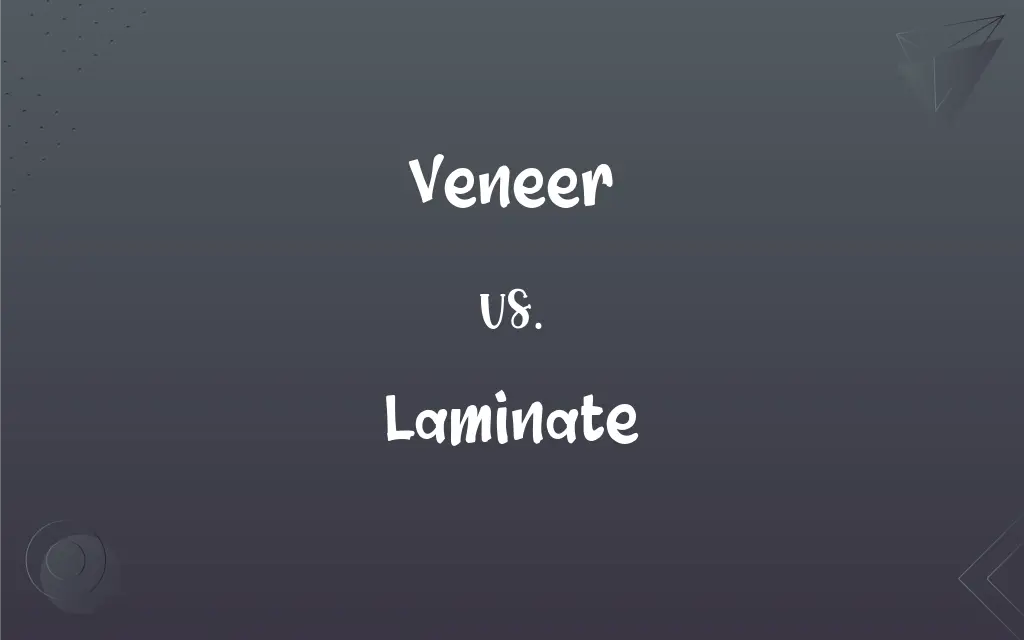Veneer vs. Laminate: What's the Difference?
Edited by Aimie Carlson || By Janet White || Published on November 11, 2023
Veneer is a thin slice of real wood. Laminate is a multi-layer synthetic product with a photographic layer simulating wood grain.

Key Differences
Veneer and laminate are both used in the world of interior designing and furniture, but they serve different purposes and have distinct characteristics. A veneer refers to thin slices of wood that are glued onto core panels, like MDF or particleboard. This gives furniture or surfaces the appearance and feel of real wood without using solid wood throughout. On the other hand, laminate is a synthetic, multi-layered product made from pressed wood. It boasts a top photographic layer that imitates the look of wood or sometimes stone.
When it comes to durability and resistance, veneer and laminate differ notably. Since veneer is made from real wood, it can be sanded, stained, and refinished, allowing for rejuvenation or alteration of the piece. Laminates are generally more resistant to scratches, moisture, and wear due to their synthetic nature. However, once damaged, they cannot be refinished and might require replacement.
The aesthetic differences between veneer and laminate are also worth noting. Veneers, being slices of real wood, have a natural and authentic appearance. This results in unique grain patterns and warm aesthetics associated with wood. Laminates, while designed to mimic wood grain or other materials, might lack the depth and authenticity of natural wood. This can be both an advantage and a limitation, depending on the desired look.
Cost considerations also differentiate veneer from laminate. Typically, veneered furniture or surfaces tend to be more expensive than their laminate counterparts. This is because veneer uses real wood, which can be more costly. Laminates, being largely synthetic, are often more budget-friendly. However, both have their place in furniture and interior design, with choices often driven by budget, desired aesthetics, and functional requirements.
Comparison Chart
Material
Thin slice of real wood
Multi-layer synthetic product
ADVERTISEMENT
Durability & Repair
Can be sanded and refinished
More scratch-resistant; can't be refinished
Aesthetic
Natural wood appearance
Photographic layer mimics wood/stone
Cost
Generally more expensive
Typically budget-friendly
Usage
High-end furniture, cabinetry
Furniture, countertops, flooring
Veneer and Laminate Definitions
Veneer
Decorative, fine-quality wood surface attached to less expensive materials.
The veneer on the cabinet added a touch of luxury to the room.
ADVERTISEMENT
Laminate
A multi-layered product with a photographic layer to mimic different surfaces.
The laminate flooring in her home was both affordable and easy to maintain.
Veneer
A thin layer of wood glued to a core material.
The dining table had a beautiful oak veneer, giving it an elegant look.
Laminate
A protective transparent film covering prints or documents.
The ID card had a glossy laminate, ensuring it was waterproof.
Veneer
A superficial or deceptively attractive appearance.
Beneath the veneer of success, he was truly struggling.
Laminate
A synthetic material made by bonding layers together, used to simulate wood or stone.
The kitchen countertop was made of a durable laminate that looked like marble.
Veneer
Thin slices of wood used as a finish or face for other materials.
The wooden veneer on the wall added warmth to the decor.
Laminate
To cover with a thin sheet of material, as for preservation.
Veneer
A thin surface layer, as of finely grained wood, glued to a base of inferior material.
Laminate
To beat or compress (metal) into a thin plate or sheet.
Veneer
Any of the thin layers glued together to make plywood.
Laminate
To divide into thin layers.
Veneer
A decorative facing, as of brick.
Laminate
To make by uniting several layers.
Veneer
A deceptive, superficial show; a façade
A veneer of friendliness.
Laminate
To split into thin layers or sheets.
Veneer
To overlay (a surface) with a thin layer of a fine or decorative material.
Laminate
Consisting of, arranged in, or covered with laminae.
Veneer
To glue together (layers of wood) to make plywood.
Laminate
A laminated product, such as plywood.
Veneer
To conceal, as something common or crude, with a deceptively attractive outward show.
Laminate
A thin sheet of material, or the material itself, such as plastic, used to laminate something.
Veneer
A thin decorative covering of fine material (usually wood) applied to coarser wood or other material.
Laminate
To assemble from thin sheets glued together.
Veneer
An attractive appearance that covers or disguises one's true nature or feelings.
Laminate
To cover something flat, usually paper, in adhesive protective plastic.
We laminated the printouts so we could use them as signage.
Veneer
To apply veneer to.
To veneer a piece of furniture with mahogany
Laminate
To form, as metal, into a thin plate, as by rolling.
Veneer
To disguise with apparent goodness.
Laminate
To cause to separate into thin plates or layers; to divide into thin plates.
Veneer
To overlay or plate with a thin layer of wood or other material for outer finish or decoration; as, to veneer a piece of furniture with mahogany. Used also figuratively.
As a rogue in grainVeneered with sanctimonious theory.
Laminate
Material formed of thin sheets glued together.
Veneer
A thin leaf or layer of a more valuable or beautiful material for overlaying an inferior one, especially such a thin leaf of wood to be glued to a cheaper wood; hence, external show; gloss; false pretense.
Laminate
Consisting of, or covered with, laminae, or thin plates, scales, or layers, one over another; laminated.
Veneer
Coating consisting of a thin layer of superior wood glued to a base of inferior wood
Laminate
Consisting of, or covered with, laminæ, or thin plates, scales, or layers, one over another; laminated.
Veneer
An ornamental coating to a building
Laminate
To cause to separate into thin plates or layers; to divide into thin plates.
Veneer
Cover with veneer;
Veneer the furniture to protect it
Laminate
To form, as metal, into a thin plate, as by rolling.
Veneer
A surface layer resembling wood, used for ornamental or protective purposes.
The veneer on the antique clock was painstakingly restored.
Laminate
To form by uniting two or more layers (in sheet form) of a material, so that the layers are bonded tightly.
Laminate
To unite (layers in sheet form) by bonding, so as to create a single object with multiple layers; - used with the material in sheet form as the object; as, to laminate plywood.
Laminate
To separate into laminæ.
Laminate
A sheet of material made by bonding two or more sheets or layers
Laminate
Create laminate by putting together several thin sheets of a material
Laminate
Press or beat (metals) into thin sheets
Laminate
Cover with a thin sheet;
Laminate the table
Laminate
Split (wood) into thin sheets
Laminate
To create by bonding together multiple layers.
He decided to laminate the document for added protection.
Laminate
A composite material used for decorative or functional purposes in construction.
The laminate on the cabinets was designed to resist stains and scratches.
FAQs
Can you refinish laminate surfaces?
No, laminates can't be refinished like veneers.
Is veneer made of real wood?
Yes, veneer is a thin slice of real wood.
Is laminate resistant to moisture?
Yes, laminate is typically more resistant to moisture than veneer.
Can veneer furniture be repaired?
Yes, veneer can be sanded and refinished if damaged.
Which is more expensive, veneer or laminate?
Generally, veneer is more expensive due to its real wood content.
Does laminate always mimic wood?
No, laminate can also imitate other materials like stone.
Is veneer prone to chipping?
Veneer can chip if subjected to hard impacts, but it can often be repaired.
How is veneer attached to furniture?
Veneer is typically glued onto core panels.
Can you paint over laminate?
Yes, with proper priming and preparation.
Which is considered more high-end, veneer or laminate?
Veneer, due to its authentic wood appearance, is often seen as more high-end.
Is laminate furniture heavy?
Laminate furniture is relatively lightweight due to its core materials.
Are laminates heat resistant?
Most laminates can resist moderate heat, but it's advised to use protection against hot items.
Can laminates be used for flooring?
Yes, there are specific laminates designed for flooring.
Does veneer warp over time?
If exposed to excessive moisture or fluctuations, veneer can warp.
How long does laminate last?
With proper care, laminate can last many years, depending on its use.
How are veneer patterns achieved?
Veneer patterns come naturally from the grain of the wood slice.
What's the typical thickness of veneer?
Veneer usually ranges from 0.5mm to 3mm in thickness.
How are the patterns in laminate created?
Laminate patterns are photographic representations, printed and sealed onto the material.
Can you stain laminate to change its color?
Laminate isn't absorbent like wood, so it doesn't take stain in the same way.
Can veneer be used for flooring?
Veneer can be used as the top layer in engineered wood flooring.
About Author
Written by
Janet WhiteJanet White has been an esteemed writer and blogger for Difference Wiki. Holding a Master's degree in Science and Medical Journalism from the prestigious Boston University, she has consistently demonstrated her expertise and passion for her field. When she's not immersed in her work, Janet relishes her time exercising, delving into a good book, and cherishing moments with friends and family.
Edited by
Aimie CarlsonAimie Carlson, holding a master's degree in English literature, is a fervent English language enthusiast. She lends her writing talents to Difference Wiki, a prominent website that specializes in comparisons, offering readers insightful analyses that both captivate and inform.































































